African swine fever
Responsible for massive losses in pig populations and drastic economic consequences, African swine fever (ASF) has become a major crisis for the pork industry in recent years. Currently affecting several regions around the world, the disease is not only impeding animal health and welfare but has also detrimental impacts on biodiversity and the livelihoods of farmers. The World Organisation for Animal Health (WOAH) works with its partners, industry and experts to support countries in their efforts to prevent and control this devastating pig disease.
Links to Code and Manual
-
Terrestrial Code
-
Terrestrial Manual
What is African swine fever?
African swine fever (ASF) is a highly contagious viral disease of domestic and wild pigs, whose mortality rate can reach 100%.
It is not a danger to human health, but it has devastating effects on pig populations and the farming economy.
The virus is highly resistant in the environment, meaning that it can survive on clothes, boots, wheels, and other materials. It can also survive in various pork products, such as ham, sausages or bacon. Therefore, human behaviours can play an important role in spreading this pig disease across borders if adequate measures are not taken.
African swine fever: a socio-economic burden and a threat to food security and biodiversity
Pigs are a primary source of household income in many countries. The spread of ASF across the world has devastated family-run pig farms, often the mainstay of people’s livelihoods and a driver of upward mobility. It has also reduced opportunities to access healthcare and education.
Moreover, pork meat is one of the primary sources of animal proteins, accounting for more than 35% of the global meat intake1. Hence, this disease poses a serious problem for food security worldwide.
This disease is also a concern for biodiversity and the balance of ecosystems, as it affects not only domestic farmed pigs, but also wild boars, including native breeds.
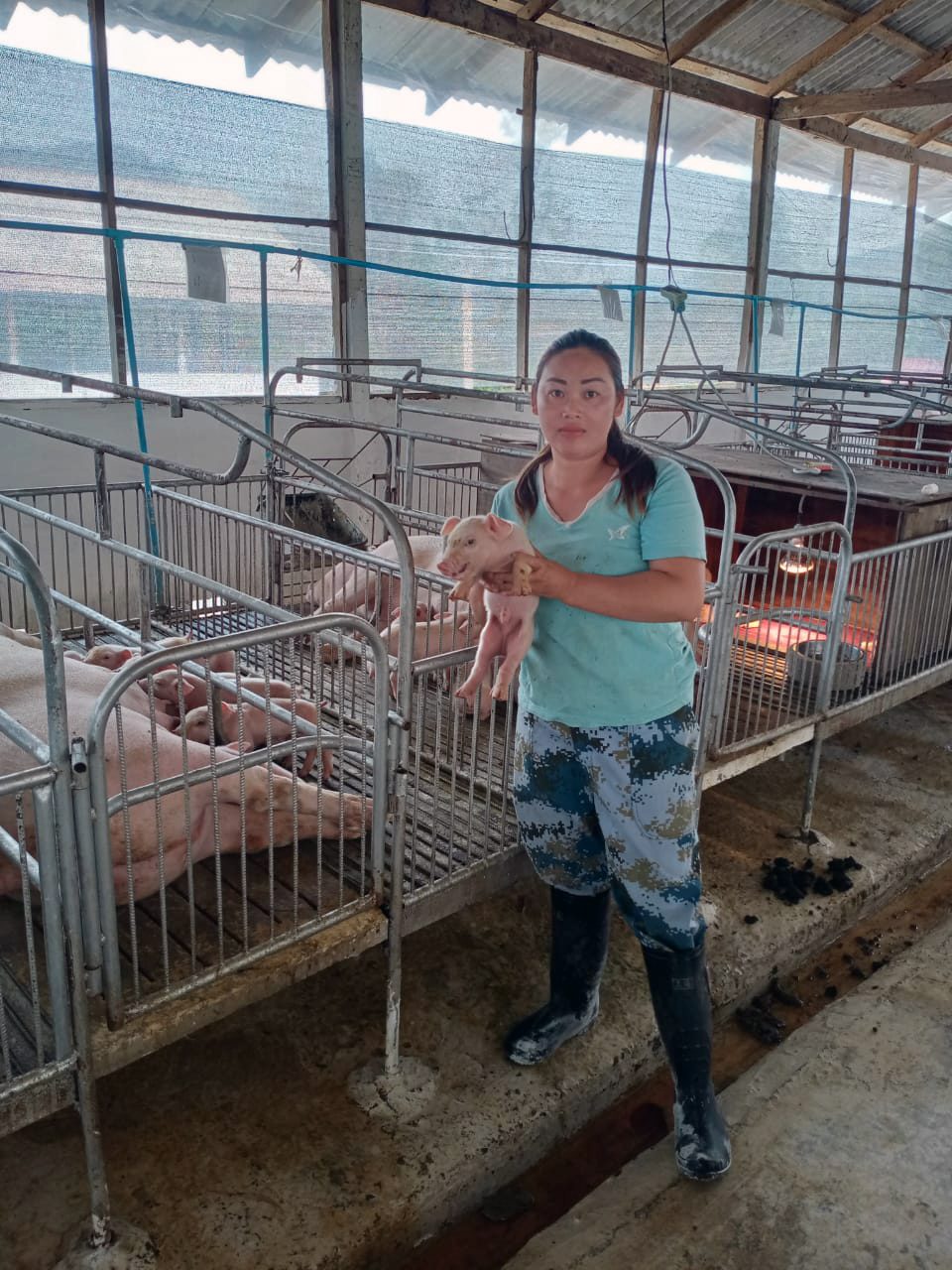
Protecting local livelihoods in Laos
Bounmee is into small scale pig farming, a common activity in Laos. With a total of 1,055 pigs, Bounmee and her family heavily depend on this activity as their source of income. Yet, her pig farming business took an unexpected turn in 2019, when African swine fever (ASF) hit her country for the first time. She lost all 1,055 pigs to this disease in 2019, impacting negatively on her financial resources to cater for her entire family.
Learn more on how we have collaborated with the national Veterinary Service to support pig farmers like Bounmee in Laos.
Global situation
ASF continues to spread worldwide, threatening pig health and welfare. The disease has reached multiple countries across Asia, the Caribbean, Europe, and the Pacific, affecting both domestic and wild pigs.
Know more about the current disease situation:
Act to stop the spread
From farmers to travellers, all those who might be in direct or indirect contact with pigs, wild boars or pork products can contribute to stopping the spread of this deadly pig disease.
You work in the animal health sector
You work in the travel sector
You are a citizen interested in helping
1 FAO Food Outlook 2019
Situation reports for African swine fever (ASF)
These reports provide an update of the ASF situation at both global and regional levels, according to the information submitted by countries through the World Animal Health Information System (WAHIS).
-
Report, Situation
African swine fever (ASF) – Situation Report 71
.pdf – 2 MB See the document -
Report, Situation
African swine fever (ASF) – Situation Report 70
.pdf – 2 MB See the document -
Report, Situation
African swine fever (ASF) – Situation Report 69
.pdf – 2 MB See the document -
Report, Situation
African swine fever (ASF) – Situation Report 68
.pdf – 2 MB See the document -
Report, Situation
African swine fever (ASF) – Situation Report 67
.pdf – 1 MB See the document -
Report, Situation
African swine fever (ASF) – Situation Reports 66
.pdf – 2 MB See the document -
Report, Situation
African swine fever (ASF) – Situation Reports 65
.pdf – 676 KB See the document -
Report, Situation
African swine fever (ASF) – Situation Report 64
.pdf – 678 KB See the document -
Report, Situation
African swine fever (ASF) – Situation Reports 63
.pdf – 684 KB See the document -
Report, Situation
African swine fever (ASF) – Situation Reports 62
.pdf – 674 KB See the document
For more animal health data visit: WAHIS
ASF evolution since 2005
2005: Presence in Africa
ASF has traditionally been present in the African continent, where it has been reported in 32 countries since 2005, when WOAH began to collect data on ASF through its World Animal Health Information System (WAHIS)
2007: Appearance in East Europe
In 2007, the disease was confirmed in the Caucasus region of Georgia. From there, the ASF virus gradually spread to neighboring countries (i.e., Armenia, Azerbaijan, Russia and Belarus) affecting domestic pigs and wild boar.
2014: Spread to the EU
The first occurrence of ASF was reported in the European Union (EU) in 2014 and since then, numerous EU countries have been affected by this devastating pig disease that continues to be reported in 16 countries (during 2020 / 2022). Two European countries have managed to eradicate the disease and submitted a self-declaration of freedom: Belgium (event resolved in March 2020) and Czech Republic (event resolved in April 2018).
2018: Emergence in Asia
In August 2018, the virus leapt to China (People’s Rep. of), which represented the first occurrence of ASF in Asia. Since then, the disease continued to spread in the Region, affecting 16 countries as of 2021.
2019/2020: Spread to Oceania
In September 2019, the first occurrence of ASF in Oceania was reported by Timor-Leste, followed by Papua New Guinea (March 2020).
2021: Reappearance in the Americas
In July 2021 the disease reappeared in the Americas after an absence of almost 40 years, having been introduced in Dominican Republic and later in Haiti.
2022 – 2024: Further spread in Africa, Asia and Europe
In January 2022, ASF genotype II was notified on the Italian mainland after around 40 years of absence. Two new countries reported the first occurrence of the disease in January as well: North Macedonia and Thailand. In March 2022, ASF was reported for the first time in Nepal.
In 2023, the following countries reported the presence of the disease for the first time: Singapore (February), Bosnia and Herzegovina (June), Croatia (June), Sweden (August), Bangladesh (November).
In 2024, Montenegro reported the first occurrence of ASF in the country in January 2024, then Albania (February), Gabon (June), and Sri Lanka (December).
More on recent ASF dynamics
83 countries
have reported ASF cases since 2005 and as of January 2025.
12 countries
have reported first occurrences of ASF since January 2022 and until January 2025.
11 countries
reported its spread to new zones since January 2022 and until January 2025.
Keeping transparency on the disease situation
Maintaining transparency on the global situation of African swine fever is key to facilitate the implementation of early measures that could halt the spread of the disease.
ASF is a WOAH-listed disease. It is therefore mandatory for national Veterinary Authorities to notify WOAH of any ASF case in a timely manner. Countries may also self-declare the absence of ASF from their territory on a voluntary basis.
Prevention is essential
Prevention in ASF-free countries depends on implementation of appropriate import policies and biosecurity measures, ensuring that neither infected live pigs nor pork products are introduced into ASF-free areas.
This includes ensuring proper treatment and disposal of waste food from aircraft, ships or vehicles coming from affected countries and policing illegal imports of live pigs and pork products from affected countries.
At farm level, the following key biosecurity principles should be implemented to keep animals healthy.
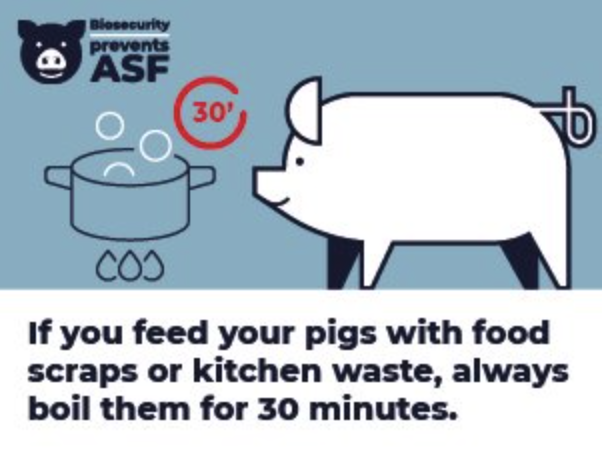
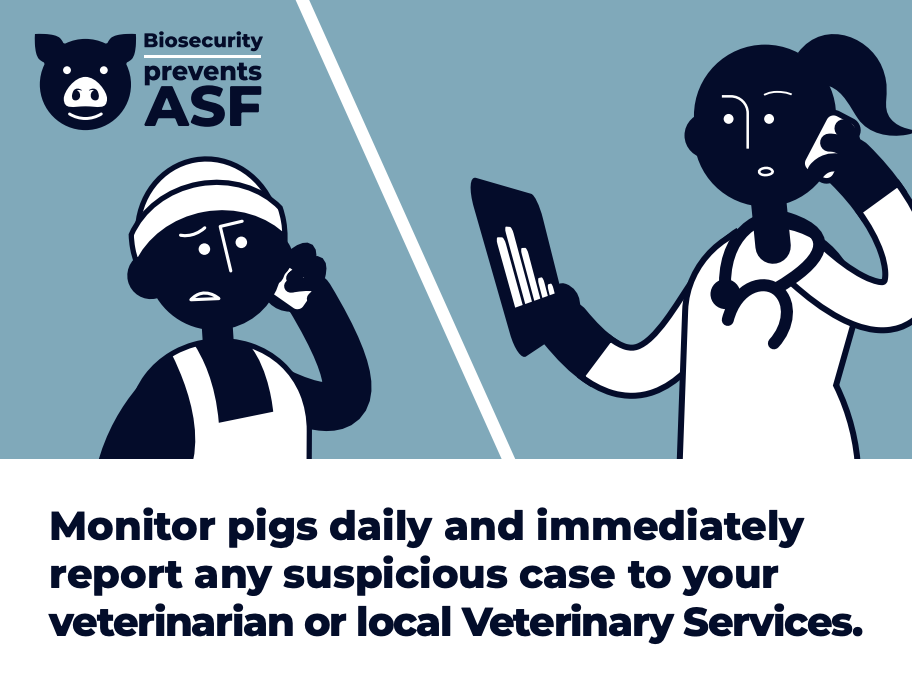

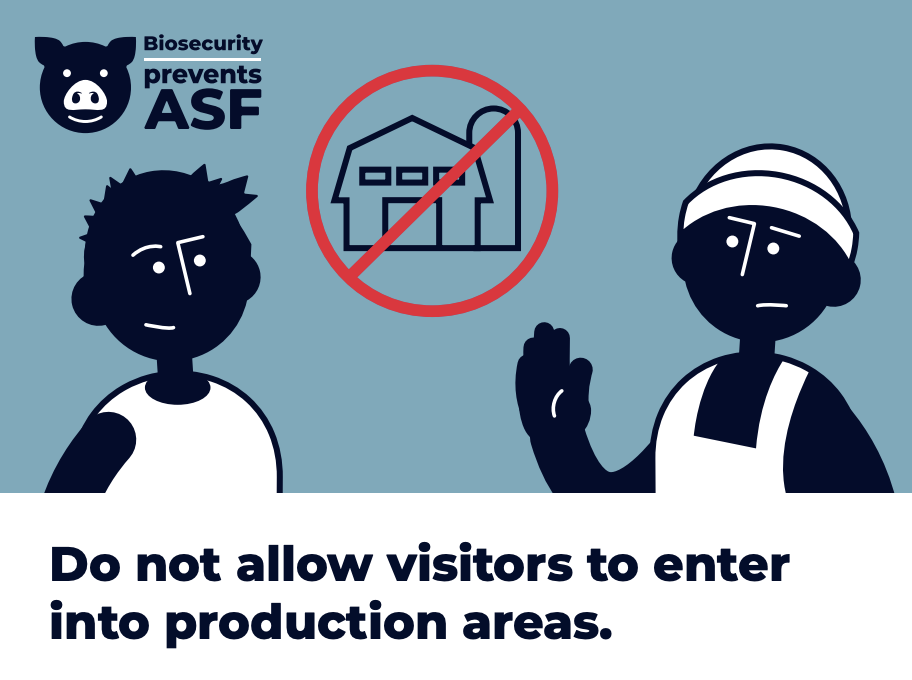
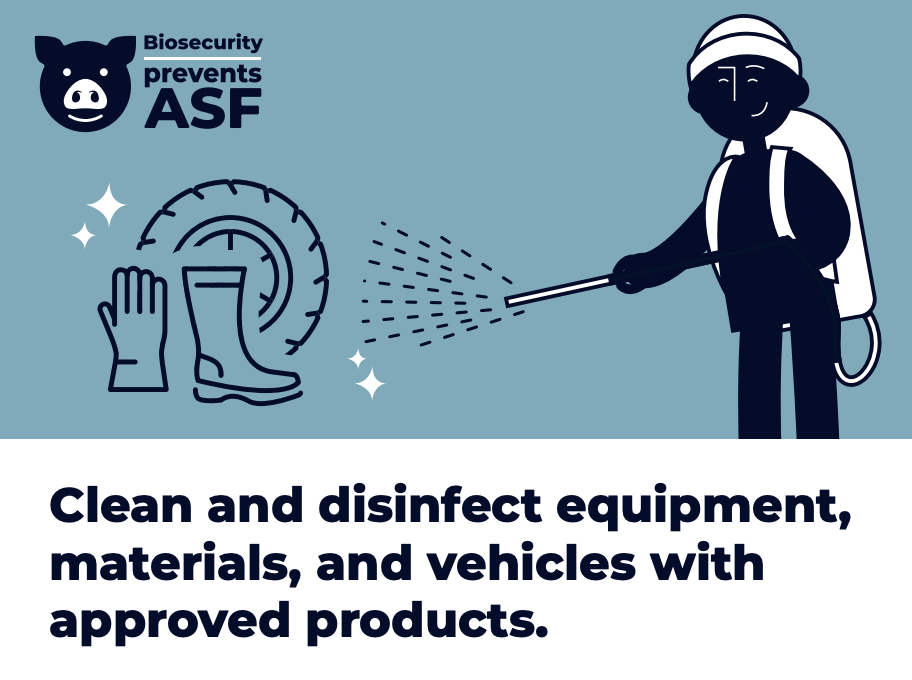
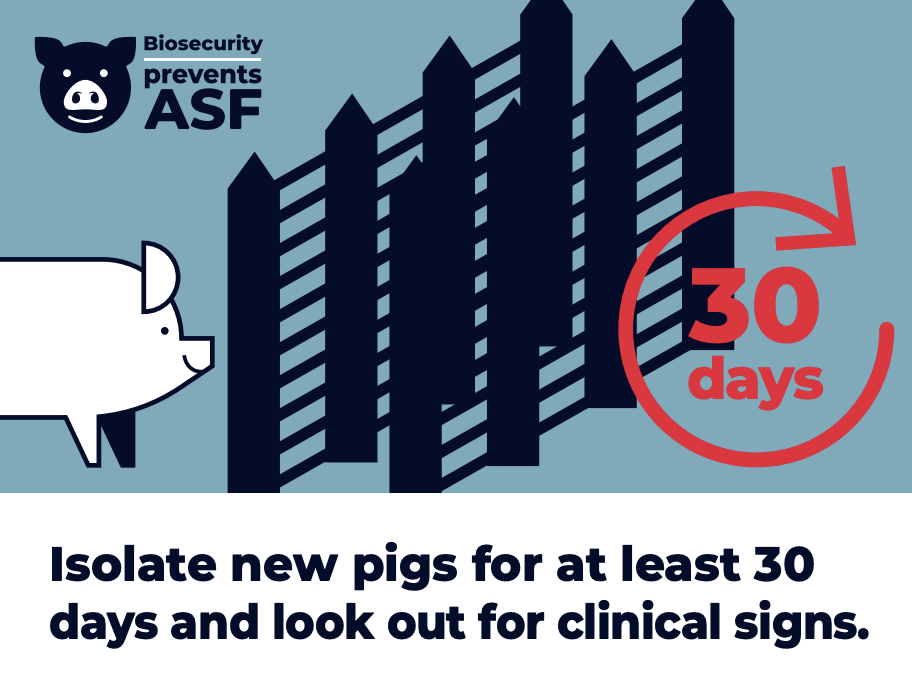
Control measures to halt ASF spread
During outbreaks and in affected countries, controlling the spread of African swine fever can be difficult and must be adapted to the specific epidemiological situation.
General sanitary measures that may be implemented include:
- early detection and humane killing of animals (with proper disposal of carcasses and waste),
- thorough cleansing and disinfection,
- zoning/compartmentalisation and movement controls,
- surveillance and detailed epidemiological investigation, and
- strict biosecurity measures on farms.
As observed in Europe and in some regions of Asia, where wild boar play a significant role in the transmission of ASF, the management of this wild population density and their interaction with low-biosecurity pig production systems is key. The good knowledge and management of the wild boar population and a good coordination among the Veterinary Services, wildlife and forestry authorities are required to successfully prevent and control ASF.
Check our technical guidelines:
-
Policy paper, Position statement
African swine fever: WOAH warns Veterinary Authorities and pig industry of risk from use of sub-standard vaccines
.pdf – 47 KB See the document -
Guidelines
Compartmentalisation Guidelines
.pdf – 9 MB See the document -
.pdf – 195 KB See the document
-
.pdf – 3 MB See the document
-
.pdf – 2 MB See the document
A global threat
African swine fever (ASF) has never been so widespread. Due to its complex epidemiology, the disease has expanded relentlessly since 2018, affecting more than 50 countries2.
Controlling and eradicating ASF becomes more challenging. Despite this daunting context, global control of the disease is possible with sustained effort and collaboration at national, regional and international levels, as evidenced by countries that have succeeded in eradicating the disease.
Today, no country is safe from ASF. The number of countries reporting outbreaks to the WOAH continues to grow. This corresponds to the biggest animal disease outbreak of our generation. Sustained investment in Veterinary Services, and the effective implementation of international standards, are needed to bring ASF under global control.
Dr. Monique Éloit
former Director General for the World Organisation for Animal Health (WOAH)
Towards the global control
The WOAH and the Food and Agriculture Organization of the United Nations (FAO) have developed a joint initiative for the Global Control of ASF. This initiative, launched under the umbrella of the Global Framework for the progressive control of Transboundary Animal Diseases (GF-TADs), brings together governments, industry and specialists to support our Members in their effort to control this devastating pig disease.
The objectives are to:
Improve the capability of countries
to control (prevent, respond, eradicate) ASF using WOAH standards and best practices that are based on the latest science.
Establish an effective
coordination and cooperation framework for the global control of ASF.
Facilitate business continuity.
Global Control on African Swine Fever
-
.pdf – 2 MB See the document
Learn more about the efforts at regional level
Africa
Amercias
Asia and the Pacific
Europe
2 As of May 2021
You are a citizen interested in knowing more about ASF and what you can do
Concrete actions you can take:
When travelling
- Avoid carrying pork products or declare them to the transport authorities
- Keep away from pig farms and wild pigs, unless strictly necessary
- Do not feed pigs with food waste or kitchen scraps containing meat products
When hunting
- Clean and disinfect your equipment on site
- Do not leave food for wild boar
- Clean and disinfect your hunting trophies before leaving the area
Your main resources:
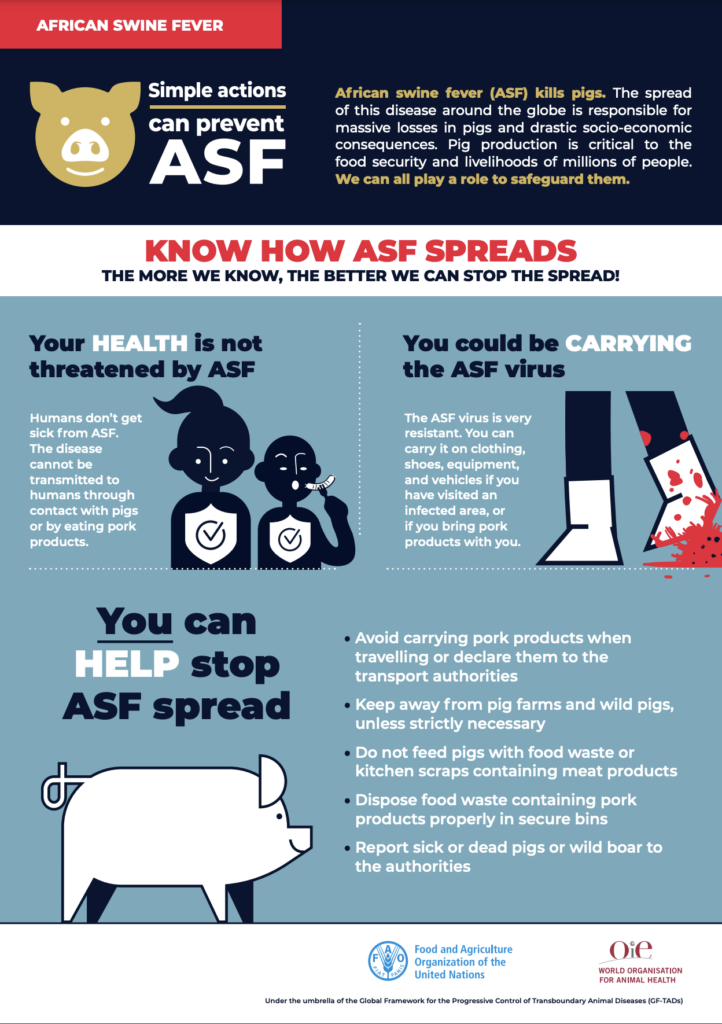
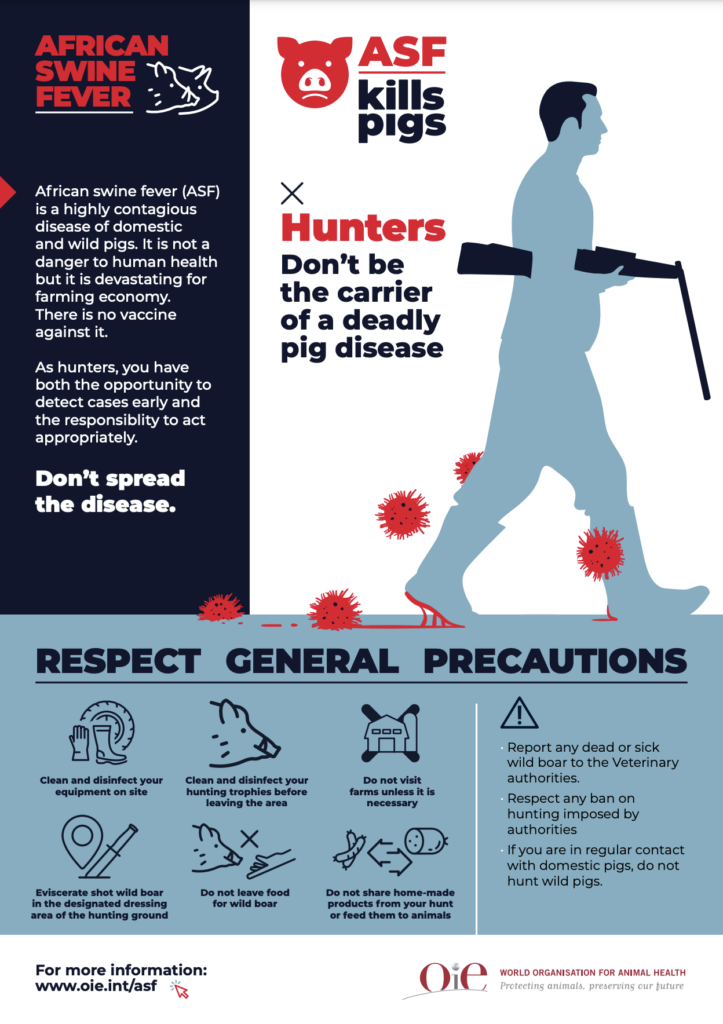
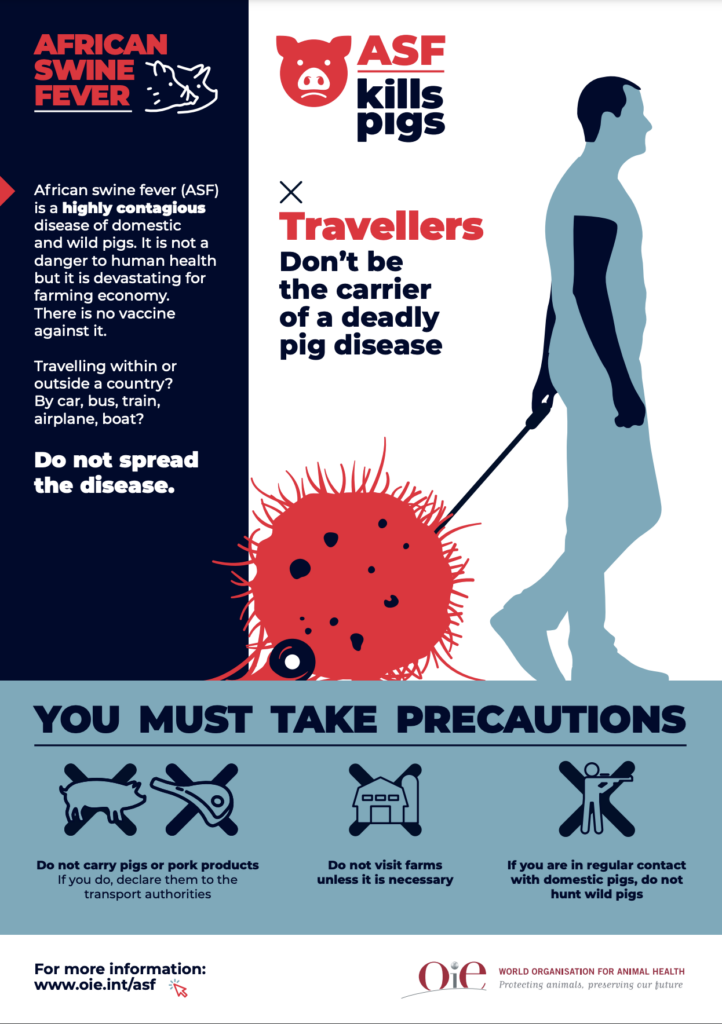
You work in the travel sector, help us spread the word on ASF
Transport authorities
Airline and airport staff
Law enforcement officers
You work with pigs. Follow the recommendations
Farmers
- Declare any suspicious case (dead or alive) to the Veterinary Authorities
- Do not feed untreated swill or kitchen scraps containing meat to your pigs
- Implement biosecurity measures in your farm and at markets
Veterinarians
- Recognise ASF clinical signs
- Confirm your diagnosis by laboratory test
- Notify national Veterinary Authorities
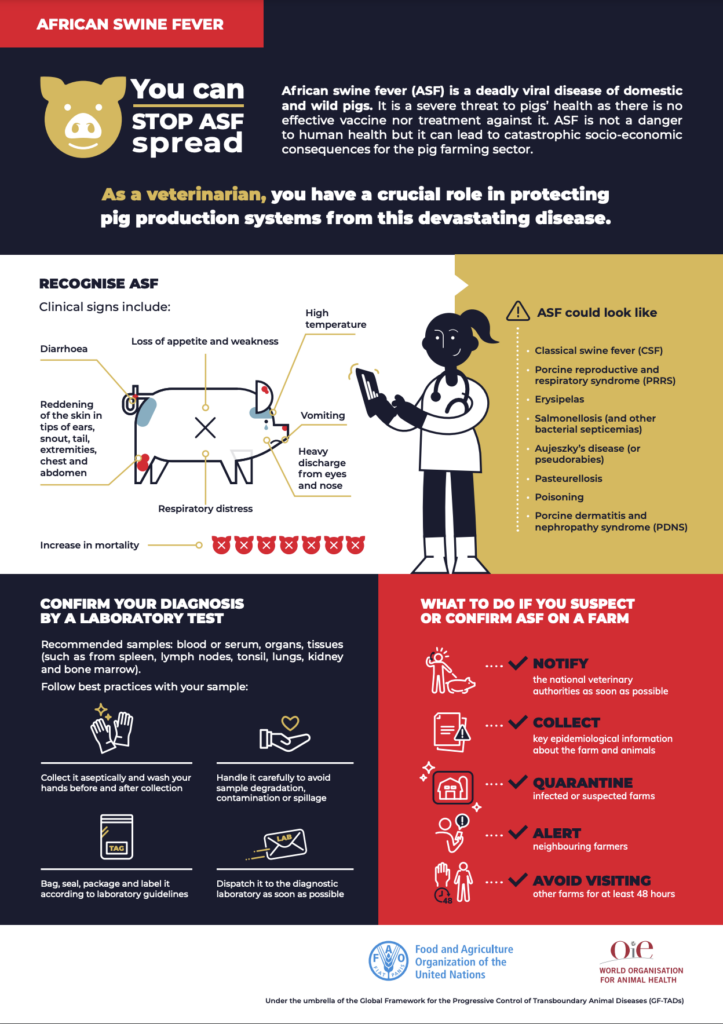
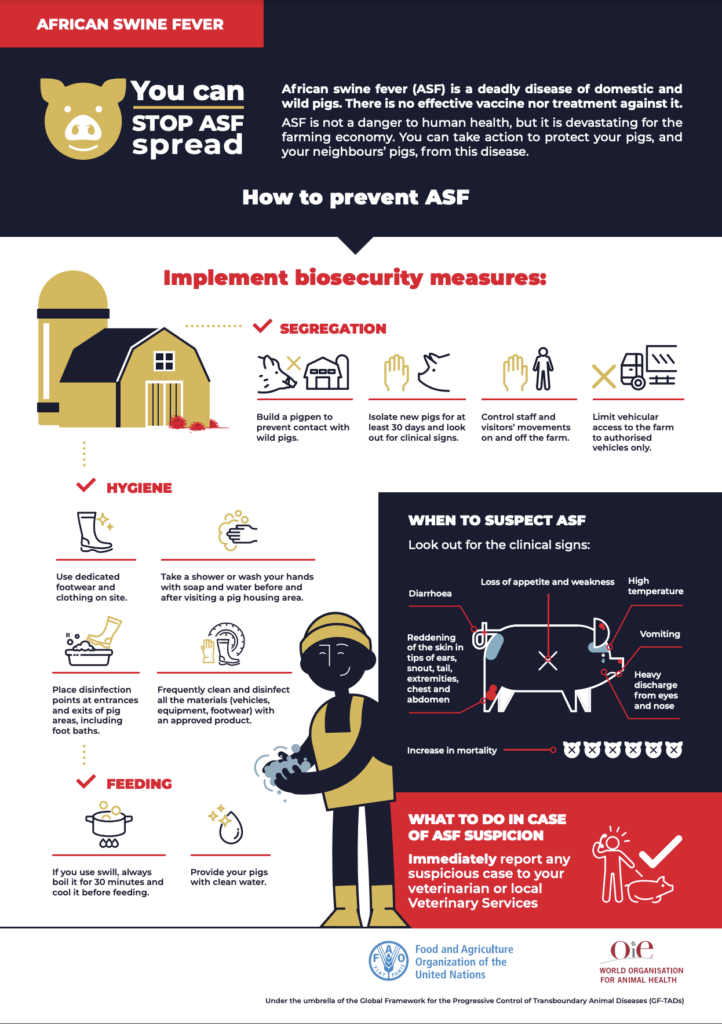
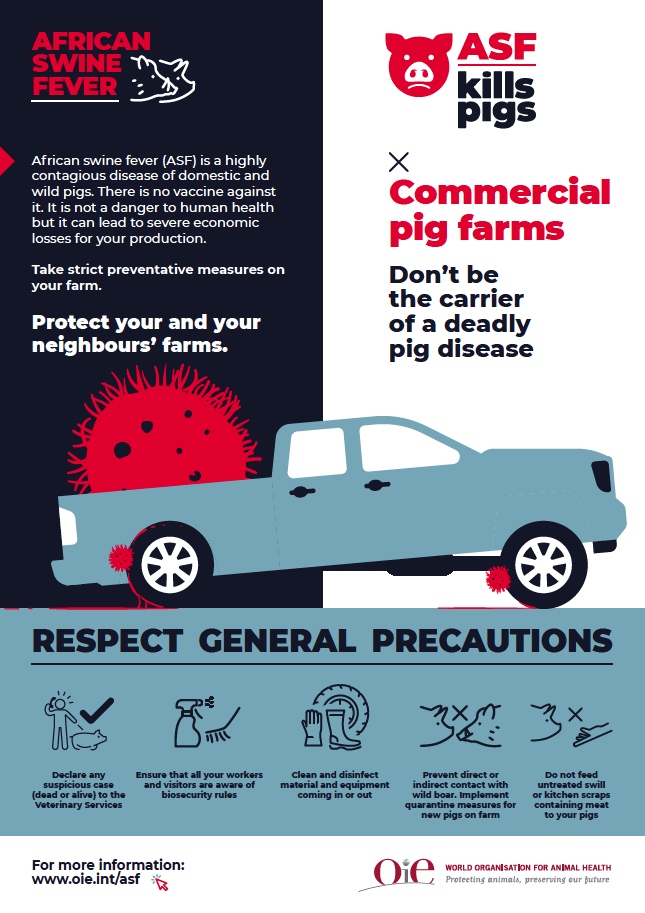
Technical resources
-
.pdf – 2 MB See the document
-
Guidelines
Compartmentalisation Guidelines
.pdf – 9 MB See the document -
.pdf – 195 KB See the document
-
.pdf – 3 MB See the document
-
Guidelines, Publication
Addressing African Swine Fever: Protocols and Guidelines for Laboratory Diagnosis
.pdf – 3 MB See the document
Other technical resources
Regional resources
Africa
Amercias
Asia and the Pacific
Europe
You are a journalist, check our publications and events on ASF
Publications
News and Events
African swine fever is a highly contagious haemorrhagic viral disease of domestic and wild pigs, responsible for serious production and economic losses due to its high mortality rate and the control measures implemented by affected countries. It is caused by a DNA virus of the Asfarviridae family.
Although signs of ASF and classical swine fever (CSF) may be similar, the ASF virus is unrelated to the CSF virus.
ASF does not affect human health.
Although signs of ASF and classical swine fever (CSF) may be similar, the ASF virus is unrelated to the CSF virus.
ASF does not affect human health.
Clinical signs and mortality rates can vary according to the virulence of the virus and the type/species of pig:
Acute forms are characterised by high fever, depression, anorexia and loss of appetite, haemorrhages in the skin (redness of skin on ears, abdomen and legs), abortion in pregnant sows, cyanosis, vomiting, diarrhea and death within 6-13 days (or up to 20 days). Mortality rates may be as high as 100%.
Subacute and chronic forms are caused by moderately or low virulent viruses, which produce less intense clinical signs that can be expressed for much longer periods. Mortality rates are lower but can still range from 30-70%. Chronic disease symptoms include weight loss, intermittent fever, respiratory signs, chronic skin ulcers and arthritis.
Different types of pig may have varying susceptibility to ASF virus infection. African wild suids may be infected without showing clinical signs, allowing them to act as reservoirs.
African swine fever has traditionally been present in Africa, until 1978 when the disease was introduced to the Italian island of Sardinia. In 2007, the disease was confirmed in the Caucasus region of Georgia and, from there, the ASF virus gradually spread to neighbouring countries affecting domestic pigs and wild boar.
The first occurrence of ASF in the European Union (EU) was reported in 2014 and since then, numerous EU countries have been affected by this devastating pig disease. Yet, two European countries have also managed to eradicate it:
Belgium (March 2020) and Czech Republic (April 2018).
In 2018, the virus leapt to China (People’s Rep. of), representing the first occurrence of ASF in Asia. Since then, the disease has continued to spread in this region and in Oceania.
In July 2021, the disease reappeared in the Americas after an absence of almost 40 years, having been introduced in Dominican Republic and later in Haiti.
Access the latest updates on the current situation.
The epidemiology of ASF is complex and varies depending on the environment, types of pig production systems, the presence or absence of competent tick vectors, human behaviour, and the presence or absence of wild pigs.
Routes of transmission can include:
– direct contact between infected pigs, domestic or wild;
– ingestion of material contaminated with the virus (e.g. food waste, feed, or garbage);
– contact with contaminated fomites (such as clothing, footwear or vehicles), or
– bite of biological vectors (soft ticks of the genus Ornithodoros), where present.
African swine fever may be suspected based on clinical signs, but confirmation must be made with laboratory tests, particularly to differentiate it from classical swine fever (CSF). Guidance on diagnostic tests for ASF can be found in the Manual of Diagnostic Tests and Vaccines for Terrestrial Animals.
ASF is not a risk to human health.
Humans do not get sick from African swine fever. The disease cannot be transmitted to humans through contact with pigs or by consuming pork products. However, meat contaminated with the ASF virus should not be used to feed pigs, as pigs can get infected this way. It is therefore recommended to avoid feeding pigs with food scraps or kitchen waste that have not been properly treated.
ASF is a WOAH-listed disease. It is therefore mandatory for national Veterinary Authorities to notify WOAH of any ASF case in a timely manner. At the same time, countries may also self-declare the absence of ASF from their territory on a voluntary basis.
Maintaining transparency on the global situation of African swine fever is key to facilitate the implementation of early measures that could halt the spread of the disease.
Biosecurity is the most important and effective measure available to prevent and control African swine fever. Rigorous and continuous implementation of biosecurity principles at farm level, as well as increasing vigilance at borders to prevent the illegal movement of ASF-infected animals or commodities, can halt the virus from entering pig herds.
It is equally important that all those who might be involved in the direct and indirect transmission of ASF are made aware and acknowledge the importance and potential consequences of their actions. In this scenario, efficient risk communication becomes also an essential component of the disease prevention efforts. To support countries, WOAH, jointly with the Food and Agriculture Organization of the United Nations (FAO), has developed an awareness campaign that targets different actors who are susceptible to play a role in the spread of the disease. Hunters, small pig farmers and large commercial pig producers, as well as travellers and the transport industry, are called upon to be actively engaged in curbing the spread of this deadly pig disease.
Despite the complexity and challenging characteristics of ASF, its global control is possible with sustained effort and collaboration at national, regional and international levels. For this reason, in 2020, WOAH launched the Initiative for the Global Control of ASF in partnership with the Food and Agriculture Organization (FAO), under the umbrella of the Global Framework for the Progressive Control of Transboundary Animal Diseases (GF-TADs). Its goal: bringing together governments, industry and experts to support our Members in their effort to control this devastating pig disease.
To achieve global control, ASF requires adequate risk management through the development and implementation of national control programmes. Through the Initiative for the Global Control of ASF, WOAH and FAO aim to improve the capability of countries to prevent, respond to and eradicate the disease using WOAH International Standards and best practices that are based on the latest science available. The goal is also to establish an effective coordination and cooperation framework for the control of ASF at global, regional and local level and to facilitate business continuity while ensuring safe production and trade to protect food systems.
